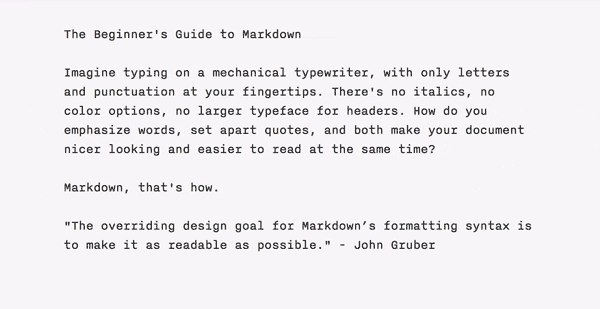Maybe you have a novel or a series of short stories in you. Maybe you're an aspiring blogger or nonfiction author hoping for fame or fortune. Or maybe you just need to crank out TPS reports each week. Any way you cut it, writing is an essential skill just about everyone needs to develop and can get better at.
Here at Zapier, we're kind of obsessed about writing. It's part of almost everything we do--from answering customer support tickets to describing what Zapier does to writing blog posts and eBooks. As a fully remote team, solid writing isn't just desirable, it's critical. Also, several Zapier team members also write their own blogs and experiment with creative writing just for fun.
In honor of NaNoWriMo (National Novel Writing Month) and NaBloPoMo (National Blog Posting Month)--in which you are challenged to write daily for an entire month--we'd like to share with you some of the best writing apps and tips we've come across over the years. Don't worry, you can use them during any month that doesn't rhyme with Movember too.
Check out these writing apps and tips, and let us know if you have others you recommend in the comments.
Choose the Best Writing App for You

Depending on what you're working on, there's a writing app that's best for the job.
The best writing apps for collaboration: If you're collaborating on a document with others, for example--one or more editors or your co-workers--you'll want to pick an online writing app with robust collaboration features, such as version control and synchronous editing.
Our 50+ team uses Quip for our company knowledgebase, but several other apps, including Google Docs, Microsoft Word Online, and Dropbox Paper might also fit the bill for you and your team.
Use note-taking apps for writing long content: You don't necessarily need word processing software--any note-taking app could do, depending on how much you're writing and how you like to work.
For example, I use OneNote primarily when writing blog posts because of its freeform structure, but others use Evernote because of its robust tagging system.
Try a distraction-free writing app: For many, the user interface is a big deal too, in addition to the app's feature set. Writing takes concentration, so the fewer the distractions within the app itself and with other apps, the better. Here are a few options:
iA Writer (for Mac): Several Zapier team members swear by iA Writer for notes and long articles thanks to its clean writing environment that "just gets out of the way," as Zapier Support Training Team Lead Thomas Hils describes it.
Ommwriter (for Mac, Windows, and iPad) is another option, offering a beautiful, distraction-free, Zen-like writing environment.
Writer requires no downloads, so you can use this web-based distraction-free app anywhere. It acts like an online typewriter, helping you focus on each word.
Plain text: Some people use plain text files to create a daily writing habit.
Combine research and writing in one app: For long-form content, short stories, and books, you might prefer a more robust writing app that consolidates both writing and research.
Scrivener (for Mac, Windows) is great because it lets you combine individual documents into a single piece--helping you structure your work--and also helps you manage your research material.
Ulysses (for Mac, iOS) is similar, but has a simpler interface and more of a focus on plain text and distraction-free writing.
Now in public beta, Airstory combines both research-saving and team collaboration (hat tip to Zapier Customer Champion Nick Simard).
Use both paper and digital tools: Or maybe you're still fond of writing things out by hand. (Ed. note: I'm guilty too!) You can still get the benefits of digital and the satisfaction of using pen and paper if you know how to create a paper notebook and digital tools system.
Find the right writing app: 15 Editorial Tools to Help You Outline, Write and Edit (Better and Faster) and 10 Unsung Apps That Help You Write Better, Organize Work, and Track Progress should help you get started
Generate More Ideas and Learn How to Write Faster

Writing apps aside, the hardest part about writing is actually getting words on the page. What will you write about? How will you start? Writer's block is an actual condition, my friends.
Here are a few things you can do to both generate more ideas and overcome writer's block:
Join a Writing Challenge
NaNoWriMo and NaBloPoMo are incredible for writing motivation because these challenges offer a concrete goal (write a novel in a month or write a blog post a day) and you get the support of thousands of other writers trying to do the same thing. You could also create your own 30-day challenge: A poem a day or three journal pages a day, a la Morning Pages.
Give Yourself Permission to Write Nonsense
The blank page is intimidating. We tend to want all of our words put down on the page to be perfect and ready to go, like Athena springing from Zeus's head fully grown and armed. But writing is a process and chances are whatever you writer will be changed later--often for the better. So let it go and just write.
As Documentation Team Lead Lindsay Brand advises:
Just start writing anything even if it’s nonsense because once you actually start, things naturally get going. I had trouble getting started the first time [with NaNoWriMo] and my friend gave me that tip. I still do it now even when writing docs or tickets, if I’m not sure how to begin I just go and then I fill in the start later.
Writing the introduction or the opening of your short story is the hardest and most important part (after the title), so we tend to get hung up on that instead of actually writing the thing. Just start somewhere, anywhere.
Don't Edit Yourself or Research As You Write
This goes along with the previous recommendation: Separate the writing and the editing process, because these are different processes. It's hard to resist the temptation to reread what you've already written and edit it before you've finished a draft, but unless you resist, you're doing the classic "two steps forward, one step back" sort of progress.
Write, then research as 99U advises or research, then write.
Tip: Avoid the temptation to do "research" on Facebook or Twitter with these distraction-busting tools.
Don't Edit Yourself as You Brainstorm
If you want to have lots of good ideas, you need to have lots of bad ones too. Learn how to brainstorm like a pro and conquer your inner idea critic.
Outsource Your Brainstorming
One of my favorite things is to drop in our general Slack channel or post a Tweet asking people what their thoughts or recommendations are for a topic. Ideas breed ideas, and you'll find people are incredibly generous with their feedback and suggestions.
Write in Markdown
The most efficient way to keep on the writing track is to never take your hands off the keyboard, yet many of us interrupt our writing to style our copy with the formatting toolbars. Even a few seconds used to apply bold formatting or indenting text can hinder the creative writing process.
Markdown is a better option. With this text formatting syntax, you use simple characters to create readable text quickly. For example, use two asterisks (**) before and after a word or phrase you want to bold. You only need to learn a few symbols for formatting copy that will look the same on just about any writing app and blogging platform.

You'll be able to write faster while applying the formatting you want. Get started with Markdown.
More writing shortcuts: If you tend to type a lot--whether for creative or prosaic purposes, the fewer characters you have to type, the quicker you'll be able to get your ideas onto the page. For that, try a text expansion app to instantly transform abbreviations into commonly typed long phrases. Or if you prefer using your vocal chords over straining your fingers, dictation software will help you write without typing. You can even use spreadsheets to write faster.
Automatically Improve Your Writing with Free Apps
Human editors are writers' best friends, but if you want to catch a typo or another embarrassing oversight before your editor does, an app can have your back.
Grammarly and ProWritingAid will check your copy for typos and grammatical mistakes--ones even Microsoft Word or Google Docs will warn you about. If you install the browser extension, it will check your copy automatically for any form field.
Hemingway App (Web, Mac, PC) converts your verbose text to short, lean sentences. Go bold. Go short. Write like Hemingway.
Additional Writing Resources
As with most skills, the best way to become a better writer is to practice writing more. But reading about writing also helps. Here are a few sites and articles you might find useful to get your writing groove on:
Articles on Writing from Brain Pickings: Wisdom from noted authors, such as Ursula K. Le Guin, Margaret Atwood, Neil Gaiman, John Steinback, and more, related to creativity, originality, and reading
Best Books for Writers: A compilation of books for creative writers from Poets & Writers
Plain Language: How to Simplify Content for a Better Reader Experience: A guide to writing n plain language from Zapier contributor Genevieve Conti
Absolute Write forums: A community of independent writers sharing techniques, projects, publishing questions, and more.
Keyboard hands via Ilya Pavlov. Sketch photo courtesy Juhan Sonin.





